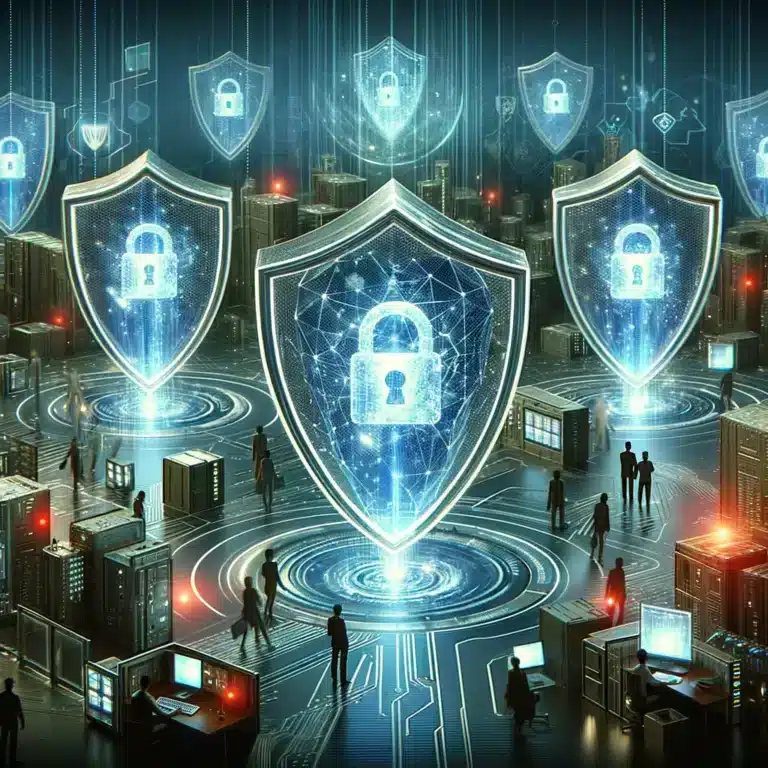How does Asymmetric Encryption Work?
Asymmetric encryption is like having a special lockbox for keeping your data secure. It uses two keys: one is a public key, which is like a mailbox on the street that anyone can drop a letter into. The other is a private key, which is secret and only the owner knows it, just like having the key to open the mailbox. These two keys work together like a team. The cool thing about this system is that even though anyone can send a message by using the public key, only the person with the private key can open it and read the message. This makes sure that when you’re talking to someone, only the right person can see what you’re saying.
When someone wants to send a private note, they use a special code, kind of like a secret handshake, that belongs to the person getting the message. This code is called the public key. Once the message is coded with this public key, it’s like it’s locked in a secure. The only way to unlock it is with another secret code called the private key, which only the receiver has. This makes sure that no one else can sneak a peek at the message. Plus, it’s like the sender leaves a special mark (called a digital signature) that proves it was them who sent it. This way of sending messages is super important for keeping things like emails and online shopping secure. It’s like the superhero of internet security, making sure only the right people can see or do certain things online.
What is Asymmetric Encryption?
Asymmetric encryption is like having a special kind of lock and key for keeping online information secure. Imagine you have a pair of keys: one you can share with everyone (public key) and one you keep to yourself (private key). When someone wants to send you a secret note, they use your public key to lock it. Once it’s locked, the only key that can open it is your private key, which only you have.
This cool setup means you can safely get messages from anyone, even over the not-so-safe internet, without having to whisper a secret code into their ear first. It’s like sending a locked box through the mail. Anyone can put something in the box using the public lock, but only you can open it with your private key.
But wait, there’s more for you! This method doesn’t just keep secrets secure; it also lets you know for sure who sent the message and that they can’t deny sending it later. It’s like getting a letter with a special seal that only the sender can make. This way, we can trust each other online, making things like shopping and sending emails safely and more reliable.
Why Do You Need Asymmetric Encryption?
Asymmetric encryption is a super handy tool for keeping your online chats and information secure. It’s like a magic trick for the internet. Firstly, it fixes a big headache we have with old-school locks and keys on the Internet, where everyone needs to have the same secret key to open and read messages. That was tricky because sharing that secret key without someone sneaky getting their hands on it was tough. But with asymmetric encryption, there’s no need to share secret keys anymore. Everyone gets a public key (like a mailbox anyone can drop stuff into), but only you have the private key (like the key to open the mailbox) to see the messages.
Then there’s this cool feature called digital signatures. It’s like sealing a letter with your unique wax seal. When you send a message, you “sign” it with your private key, which is like your personal stamp. The only way to check if the seal is legit is by using your public key. This proves the message was really from you and hasn’t been messed with along the way. It’s like sending a letter that no one else can open or change, making sure it’s just between you and the person you’re sending it to.
Asymmetric encryption is super important for you to keep things secure on the internet, especially when you’re doing things like online banking, shopping, or sending private messages. It’s the secret sauce behind the scenes that makes sure your important information, like credit card details and personal info, stays safe from hackers and other online dangers.
Think of it like a special invisible shield for websites, powered by something called SSL/TLS. This shield wraps around your information, keeping it hidden from anyone who shouldn’t see it. In today’s world, where it seems like hackers are always lurking around the corner, having this kind of protection is like having a superhero guard your secrets. It’s something we really can’t do without if we want to keep our online lives safe and sound.
How Does Asymmetric Encryption Work? Let’s Explore This Concept With An Example
To get how asymmetric encryption works, let’s look at a simple story. Imagine Alice wanting to send a secret note to Bob. They decided to use a special method called asymmetric encryption. This method is like having two keys for a secret box. One key is a public key that everyone knows about, and the other is a private key that only the owner keeps hidden.
Step 1: Key Generation
Bob generates a pair of keys. He keeps his private key a secret and gives his public key to Alice.
Step 2: Encryption
Alice pens down her message and then locks it using Bob’s public key, sort of like sealing a letter in an envelope that only Bob can open.
Step 3: Transmission
Alice sends this locked-up message through the internet. If anyone else grabs it, they won’t be able to open it because they don’t have Bob’s special key.
Step 4: Decryption
Bob gets the message and uses his private key, like his own secret letter opener, to unlock it. Now, he can read what Alice wrote just for him.
This way of sending messages keeps things private just between Alice and Bob. And if Bob sends a message back using Alice’s public key, it’s just as secure. From this story, we can see how asymmetric encryption lets people talk securely without needing a secure way to share keys first. It’s a strong base for keeping our digital world safe and trustworthy.
Benefits of Using Asymmetric Encryption for Data Security?

Asymmetric encryption offers a lot of perks, making it a super valuable tool for keeping data secure as we do more and more things online.
- Enhanced Security: The biggest perk of asymmetric encryption is how secure it is. Because the key that unlocks the data is never shared, there’s a much smaller chance of someone getting their hands on it. Even if someone grabs the public key, they can’t do anything without the matching private key, so the data stays secure.
- Secure Key Distribution: With asymmetric encryption, sharing keys is a breeze. Public keys can be passed around without any worry about security, making the whole process of locking and unlocking information simpler. This means people can chat safely, even on not-so-safe channels.
- Authentication and Non-repudiation: When you sign a digital note or message with your private key, it’s like putting your unique stamp on it. This proves you’re you and makes it so you can’t say “I didn’t send that” later on.
- Versatility: Asymmetric encryption isn’t just a one-trick pony; it’s used in loads of other security measures online, like digital signatures, secure emails, and making sure websites are secure (SSL/TLS). It’s a big deal in keeping our online world secure.
- Confidentiality and Integrity: It’s not just about keeping secrets; asymmetric encryption also makes sure the data doesn’t get messed up or changed along the way. If something’s off, it’ll be noticed, keeping the data as it was meant to be.
All these good things about asymmetric encryption make it a super helpful friend when it comes to keeping important information secure. It makes sure that data stays private, real, and unchanged as it moves through the online world.
Four Main Characteristics of Asymmetric Encryption
Asymmetric encryption is very special because of four big features that make it different from other ways to keep digital messages secure.
- Key Pairing: At the heart of asymmetric encryption is the key pair idea, where you have a public key and a private key that is connected specially. Even though they’re linked, you can’t figure out the private key just by looking at the public key. This setup lets you lock data with the public key, but only the matching private key can unlock it.
- Public Key Distribution: Since the public key doesn’t give away secrets, it can be shared with anyone. This means anyone can use it to send secure messages to the key’s owner, making it easy to talk safely without needing to swap secret codes first.
- Private Key Confidentiality: The private key is kept under wraps by its owner and isn’t shared or sent out. This keeps the unlocking process secure, making sure that only the person the data is meant for can see it.
- Computational Imbalance: The way asymmetric encryption is made, locking stuff up with the public key is pretty easy, but unlocking it with the private key takes a lot more work. This uneven setup is on purpose, adding an extra layer of security by making it tough to work backward from the public key to get the private key.
These features make asymmetric encryption a strong and secure way to protect information. They help make sure that digital messages stay private and real in a world that’s more and more connected.
The Advantages & Disadvantages of Asymmetric Encryption
Asymmetric encryption is a great tool for keeping your data secure online, but it’s important to know it has its own good and not-so-good points to think about.
| Advantages | Disadvantages |
| Enhanced Security: Using two keys, one public and one private, makes asymmetric encryption secure. It’s super hard for someone who shouldn’t see the information to get in. | Performance: Asymmetric encryption takes more time than the simpler symmetric kind because it uses complicated math. This might be a problem when you need to lock or unlock a lot of information quickly. |
| Simplified Key Distribution: You can share the public key with anyone without making things less secure. This gets rid of the tricky problem of having to secretly pass keys around, which you have to do with other types of encryption. | Key Management: It’s easier to share keys with asymmetric encryption, but if you have a lot of them, especially in big groups or companies, it can get challenging to keep everything straight without a good system in place. |
| Digital Signatures: With asymmetric encryption, you can put digital signatures on messages or documents. This checks that the message is real, hasn’t been changed and comes from who it says it does. | Resource Intensity: Locking and unlocking information with asymmetric encryption needs a lot of computer power. This could be too much for gadgets with less oomph, like some smart devices. |
| Versatility: It’s used in a bunch of important security stuff, like making sure websites are safe (SSL/TLS) and keeping emails private (PGP). This makes it super handy in lots of different situations. | Scalability Issues: When more people join a network and use asymmetric encryption, things can get pretty complicated. Everyone has to juggle multiple keys, making the system harder to manage as it gets bigger. |
Even though it has some downsides, the strong points of asymmetric encryption, like its top-notch security and flexibility, make it a must-have for keeping our digital world secure. Figuring out how to balance the good and the not-so-good parts is crucial for setting up cyber security that works well.
In conclusion
In wrapping up our exploration of asymmetric encryption, it’s clear that this method is a key part of keeping our online world secure. Thanks to its clever system of using two keys, it solves big problems like security sharing keys, checking who’s sending messages, and making sure data stays the way it’s supposed to. It’s super important for staying connected safely. Sure, there are some issues, like it can be slow and managing all those keys can be tough, but the good stuff makes up for it, especially when keeping things secure is a top priority. As we move through the online world, understanding and using asymmetric encryption is crucial for keeping our information safe and making sure we can trust our digital chats and transactions. It’s all about finding the right balance between what it can do and its challenges as we depend on this technology to protect our digital lives.
FAQs
How does asymmetric encryption ensure secure communication?
Asymmetric encryption ensures secure communication by allowing anyone to encrypt a message using the recipient’s public key, which can only be decrypted by the recipient’s private key. This means that even if the encrypted message is intercepted, it cannot be decrypted without the corresponding private key.
What are public and private keys?
Public and private keys are a pair of cryptographic keys used in asymmetric encryption. The public key is shared openly and is used to encrypt messages or verify digital signatures. The private key is kept secret and is used to decrypt messages or create digital signatures.
Can the public key be used to decrypt a message?
No, the public key cannot be used to decrypt a message. Only the private key, which is kept secret by the owner, can decrypt messages that were encrypted with the corresponding public key.
Is asymmetric encryption the same as SSL/TLS?
Asymmetric encryption is a key component of SSL/TLS protocols but not the same thing. SSL/TLS uses asymmetric encryption for secure key exchange and then often switches to faster symmetric encryption for the rest of the communication session.







